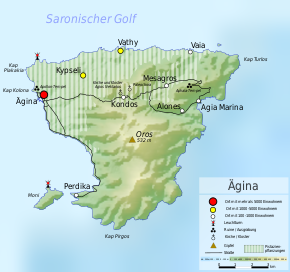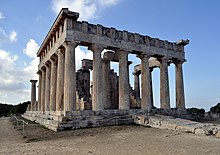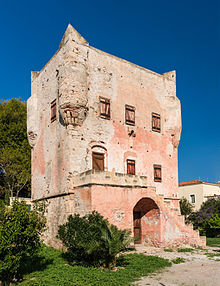Aegina
|
Municipality of Aegina Δήμος Αίγινας (Αίγινα) |
||
|---|---|---|
|
|
||
| Basic data | ||
| State : |
|
|
| Region : | Attica | |
| Regional District : | Islands | |
| Geographic coordinates : | 37 ° 44 ′ N , 23 ° 30 ′ E | |
| Area : | 87.4 km² | |
| Residents : | 13,056 (2011) | |
| Population density : | 149.4 inhabitants / km² | |
| Community logo: | ||
| Seat: | Aegina | |
| LAU-1 code no .: | 5204 | |
| Districts : | no | |
| Local self-government : |
4 city districts 4 local communities |
|
| Website: | www.discoveraegina.gr | |
| Location in the Attica region | ||
Aegina ( modern Greek Αίγινα Egina ( f. Sg. ) [ ˈƐʝina ], ancient Greek Αἴγινα Aigina , German 'goat island' , Latin Aegina ) is a Greek island in the Saronic Gulf in the west of the Aegean , also called the Gulf of Aegina. The island is 25 km southwest of Athens . The municipality (δήμος, dímos ) Aegina has around 13,500 inhabitants. The capital of the island with almost 8000 inhabitants is also called Aegina.
Geography and geology
Aegina belongs to the Saronic Islands in the gulf of the same name, which is bordered to the north by Attica (area around Athens) and to the south by Argolis (eastern Peloponnese). The island has an area of about 87 km². The highest point is at 531 meters above sea level. d. M. the mountain Óros .
Geologically, Aegina is divided into three parts. It consists of a Cretan limestone plinth, which stretches as a low mountain range from the neighboring island of Moni in the southwest to Mount Parliagos in the northeast, as well as a Quaternary volcanic complex and neogene shallow water sediments. The island is roughly in the shape of a triangle tapering to the south, the southern half of which is covered with hard lava rock . Along with Methana , Poros , Milos , Santorin , Kos , Giali and Nisyros , Aegina is one of the active volcanoes of the Aegean island arc .
The vegetation and the soil correspond to the geological conditions. The south is stony, barren and sparsely forested, the north is relatively densely populated and has fertile soils. In some coastal valleys, also in the southern part, pistachios , olives and wine are grown. A fertile valley stretches from the city of Aegina in the northwest to the east through the inland to Mesagros . A small mountain range separates this valley from a fertile plain that gently slopes north to the sea. Aegina has hardly any natural fresh water resources.
climate
The climate is mild and there is little rainfall. Temperatures in the middle of August can reach up to 50 ° C in the shade, in winter in some years (for example 2015), snow falls occasionally in the mountain regions. The climatic conditions and the proximity to the Attic mainland made the island the summer residence of wealthy Athenians.
history
The name of the island is said to go back to the legend of the nymph Aigina , who gave birth to her son Aiakos, who was born by Zeus on the island, which was then called Oinone or Oinopia .
Aegina was since the 3rd millennium BC. Inhabited; apparently there were close ties to the Minoan culture in Crete. Between the 12th and 10th centuries BC The island was abandoned by the population around 950 BC. BC but - probably by settlers from Epidaurus - colonized again. It developed into an important trading center. The island had its heyday around 650 in the archaic epoch of Greece. At that time, the Aegina polis was the first city in the Greek motherland to mint coins. The Aeginetes had learned from the Ionians that these facilitate trade. The coins were named turtles after their motif; they were in use until 450 BC. Spread over a large part of the Mediterranean basin , Aegean merchant ships came to Spain , Egypt and the Black Sea . After Etruria in the 6th century BC BC Sostratos, mentioned by Herodotus as a particularly rich Aegine trader, has close ties. He may have once a while Etruscan Tarquinia marble Anker found the "Apollo of Aegina" ordained . In Etruria, numerous pieces of Attic ceramics from the second half of the 6th century with the signature SO , which were presumably Sostratos' goods were found. From 450 BC With the growing power of Athens, the importance of the island in sea trade declined and the sea turtle on the coins was lost in 404 BC. Because of this development replaced by the tortoise.
In view of the threat to Greece from the ever expanding Persian Empire in the 5th century BC Aegina showed herself to be conciliatory in the interests of her own trading position towards the great power. This Persian-friendly attitude, which set it in opposition to Athens, revised Aegina after the Attic city was occupied by the Persians and sided with the Greeks at the battle of Salamis . Because of its sea experience, it contributed significantly to the victory over the Persians.
Nevertheless, Athens, who wanted to put an end to Aegina's economic competition, attacked around 460 BC. His fleet and forced the island 456 BC. To surrender. Aegina was forced to join the Attic League and had to pay high tributes to Athens. "The thorn in the side of Piraeus", as Pericles called the island rival, had run out. With the beginning of the Peloponnesian War in 431 BC Most of the inhabitants were driven out and replaced by Attic colonists because Athens feared that Aegina could support the Spartans . The original inhabitants could after the end of the war in 404 BC. But Aegina never regained its old importance, even if the island was later repeatedly visited by Roman emperors.
A devastating blow struck Aegina in 1537. The pirate Khair ad-Din Barbarossa destroyed the island in the Turkish-Venetian war, killed almost all men and kidnapped 6,000 women and children in order to sell them on the slave markets of the Orient. In 1828 (January 26th) Ioannis Kapodistrias, the first President of Free Greece, was sworn in on Aegina. Aegina was the capital of the new state from January 12 to October 3, 1828 , when Nafplio took over this task. The first Republic coins were minted in Aegina in 1829
Many ancient Olympians came from Aegina, as the Oden Pindars and the work of Pausanias testify.
Attractions
The most famous sight on the island of Aegina is the late Archaic temple of the main goddess Aphaia , which stands 13 km east of the main town on a hill. It was only built about 50 years after a previous building around 500 BC. Rebuilt. His gable figures, known in archeology as Aigineten , were sold to the Bavarian Crown Prince Ludwig in 1812 and have since been in the Glyptothek in Munich . The excavation museum at the Aphaia temple contains the most important finds from the German excavations in the temple area, which were completed in 1988.
There are also remains from antiquity in the main town of Aegina (excavation Aigina-Kolona) (prehistoric settlement with a mighty surrounding wall , archaic-classical sanctuary with a column from a temple of Apollo , burial mound from the 6th century BC) and on the summit of Óros ( Mycenaean city complex, Zeus sanctuary from the 5th century BC). In the excavation area Aigina-Kolona there is also a museum with the mainly prehistoric finds made there. The floor mosaic of the synagogue of Aegina is also located here .
In the interior of the island, on the road of Aegina to Agia Marina, is the new Agios Nektarios -Kuppelkirche ( 37 ° 44 '49 " N , 23 ° 29' 4" O ). It was built in honor of the youngest Orthodox Saint Nectarius of the Pentapolis . Directly behind the church is the monastery of Agios Nektarios , in which the chamber, which Nektarios lived in from his retirement until his death, can be visited.
The abandoned town of Paleochora is about 500 m from the Agios Nektarios domed church . In the Middle Ages, Paleochora was the capital of Aegina, which was inland to protect against pirates. Around 1800 Paleochora was abandoned. While the houses in the village fell into disrepair, 32 churches, mainly from the 13th and 14th centuries, remained.
Economy and Infrastructure
The main focus of agriculture on the island is the cultivation of pistachios : 3–5% of the world harvest comes from Aegina. In addition, tourism is playing an increasing role; the main tourist town is Agia Marina.
Personalities
- Paulus of Aegina (it is assumed 625–690), most famous Greek doctor of the Byzantine Empire .
- Athanasia of Aegina (around 790 – around 860), holy nun.
- Nektarios von der Pentapolis (1846–1920), monk and saint of the Greek Orthodox Church.
- Ioannis Kapodistrias (1776–1831), first Prime Minister of Greece, ruled Greece from his private residence in the island's capital from 1828 to 1829 before the capital was moved to Nafplio .
- Nikos Kazantzakis (1883–1957), probably the most famous Greek writer of modern times, lived from 1936 to 1948 in his house on the island (on the coastal road now named after him, only a few hundred meters from the lighthouse on the northwest corner of the island) and wrote well-known works such as Alexis Sorbas .
See also
literature
- V. Dietrich, P. Gaitanakis, I. Mercolli, R. Oberhaensli: Geological map of Greece: Aegina Island. 1: 25,000. Immanuel Friedländer Vulkaninstitut Foundation, Zurich 1991 (with a detailed description of the geological conditions on the reverse).
- Klaus Hoffelner: The Apollon Sanctuary. Temple, altars, Temenos wall, Thearion . Verlag Philipp von Zabern, Mainz 1999, ISBN 3-8053-2030-2 (Alt-Aegina, edited by Hans Walter and Elena Walter-Karydi , Volume I, 3).
- J. Lesley Fitton (Ed.): The Aigina Treasure: Aegean Bronze Age Jewelry and A Mystery Revisited. The British Museum Press, London 2008, ISBN 978-0-7141-2262-5 .
- Gustav Hirschfeld : Aigina 1 . In: Paulys Realencyclopadie der classischen Antiquity Science (RE). Volume I, 1, Stuttgart 1893, Col. 964-968.
- Anne Yannoulis: Aegina. Guide to the island . P. Kokkalis, Athens 1992, ISBN 960-85262-1-3 .
Web links
- Computer models of the temple
- OeAI website on the Aegina project
- Website of the University of Salzburg on the Aegina project
Individual evidence
- ↑ Results of the 2011 census at the Greek Statistical Office ELSTAT ( Memento of November 13, 2011 in the Internet Archive )








